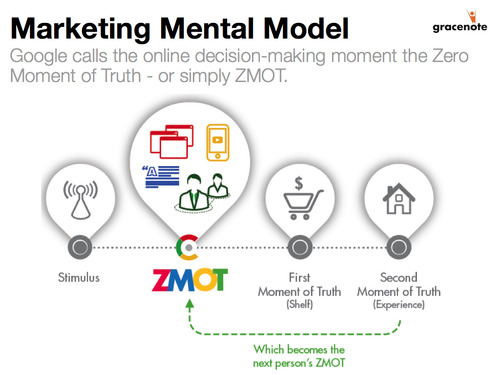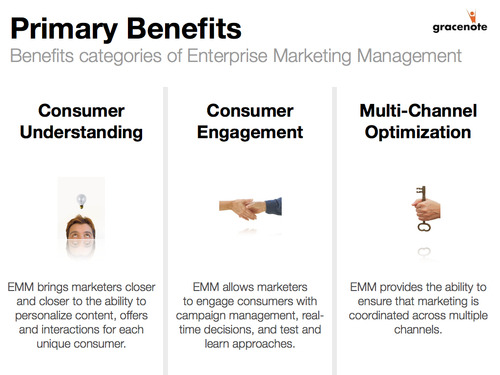The Next Major Wave of Enterprise Technology
In recent years, Enterprise Marketing Management has caught the attention of marketers, agencies, consulting firms, software vendors, and investors around the globe. Marketers are adopting technology at a rapid pace, and the pace of this adoption may take many by surprise. Gartner predicts that Chief Marketing Officers will spend more on information technology than Chief Information Officers by 2017. Mergers and acquisition activity also confirms this trend. According to a report from the Jordan, Edmiston Group, Oracle, IBM, Salesforce and Adobe have invested over $20 billion in acquiring marketing technology firms over the past 3 years. Companies that strategically apply these technologies will gain a competitive advantage in optimizing consumer interactions, increasing new consumer acquisition, and enhancing existing consumer loyalty. But, the road ahead may feel more like an adventure than a walk in the park.
Consumer Changes
For many years, marketing involved interrupting the consumer. It’s the thing most people dislike about marketing. Consider how you feel about spam, junk mail, calls during dinner, pop up ads, etc. They’re annoying, and people tune them out.
Direct marketing meant mailing promotional materials about products and services to millions of consumers. Smart marketers used data and analytics to better target consumers. But, even still, the response rates for direct mail were very low, and those response rates declined steadily every year. Mass marketing techniques, such as advertising on television, have also become much less effective.
For successful marketing today, consumers demand two things:
- Know and treat me as a unique individual with unique wants and needs rather than as part of a faceless mass market; and
- Engage me when and where it is convenient for me with content and offers that are timely and relevant.
Google summarizes this new environment nicely with a term they coined to describe how consumers shop today, the Zero Moment of Truth.
“It’s a new decision-making moment that takes place a hundred million times a day on mobile phones, laptops and wired devices of all kinds. It’s a moment where marketing happens, where information happens, and where consumers make choices that affect the success and failure of nearly every brand in the world.”
The Zero Moment of Truth occurs online, well before the consumer has reached what was traditionally considered the moment of truth, the consumer’s selection of the product or service and their purchase. Google’s model also shows a second moment of truth, when the consumer experiences what they’ve purchased. More than ever, consumers share their experiences, both positive and negative, impacting the ZMOT for their colleagues, friends and family. All of this leads Gartner to predict that by 2015 digital marketing campaigns will influence 80 percent of consumer discretionary spending.

Is Enterprise Marketing Management the Answer?
So, what exactly is Enterprise Marketing Management?
Given the rapid changes underway, it shouldn’t surprise anyone that a consistent definition of EMM is hard to come by. Gartner describes it as follows:
“Enterprise marketing management (EMM) encompasses the business strategies, process automation and technologies required to effectively operate a marketing department, align resources, execute customer-centric strategies and improve marketing performance. From a technology perspective, EMM is an integrated, enterprisewide platform for marketing, including all roles and functions that support executional, operational and analytical marketing processes.”
-Gartner, Inc., “Magic Quadrant for Enterprise Marketing Management”
Wikipedia defines EMM as:
EMM consists of other marketing software categories such as Web Analytics, Campaign Management, Digital Asset Management, Web Content Management, Marketing Resource Management, Marketing Dashboards, Lead Management, Event-driven Marketing, Predictive Modeling and more. The goal of deploying and using EMM is to improve both the efficiency and effectiveness of marketing by increasing operational efficiency, decreasing costs and waste, and standardizing marketing processes for an accurate and predictable time to market.
EMM helps marketers manage, measure, and optimize customer interactions. The illustration below depicts many of the components of EMM; however, the definition is likely to evolve over time.

EMM provides many benefits that can be grouped into three buckets:
1. Consumer Understanding
EMM technologies enhance consumer understanding with web analytics, marketing analytics and voice of the customer. EMM brings marketers closer and closer to the ability to personalize content, offers and interactions for each unique consumer.
2. Consumer Engagement
EMM allows marketers to engage consumers with campaign management, real-time decisions, and test and learn approaches. It drives deeper levels of engagement while also providing the infrastructure to manage these activities in a cost-effective way.
3. Multi-Channel Optimization
EMM provides the ability to ensure that marketing is coordinated across multiple channels. It helps marketers make sure that interactions on the e-commerce site are consistent with email interactions, call center interactions, the retail experience, etc. And, it allows marketers to track and analyze behavior across each of these touchpoints.

Up next: why now is the time to define your Enterprise Marketing Management strategy and how to define the ROI of EMM investments



